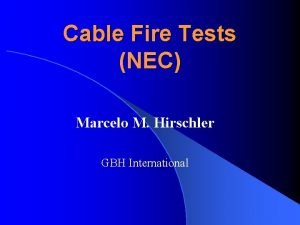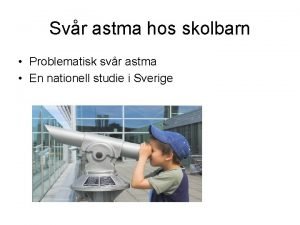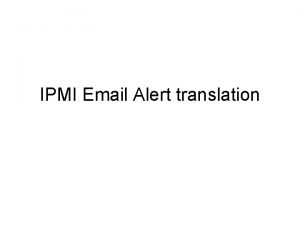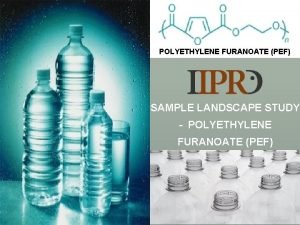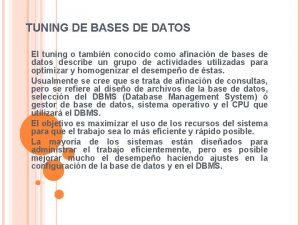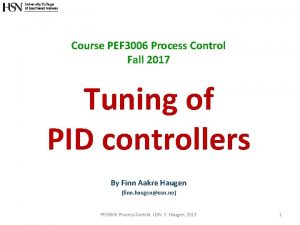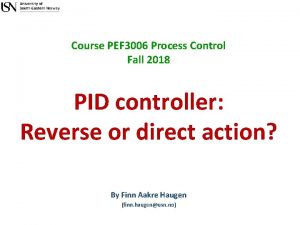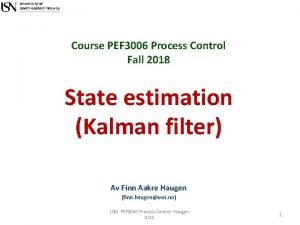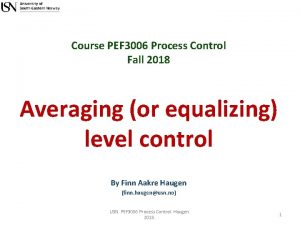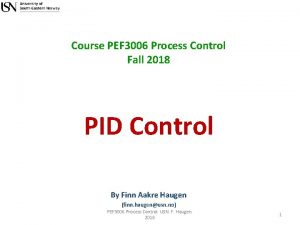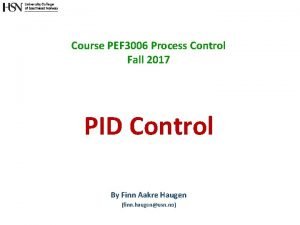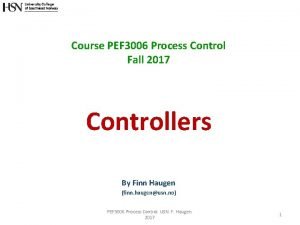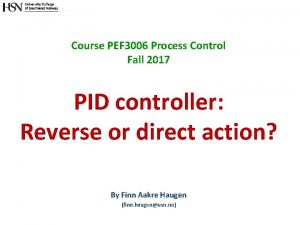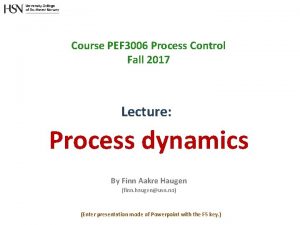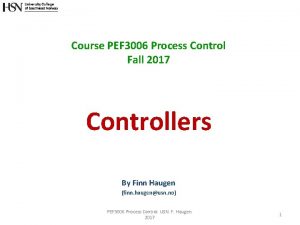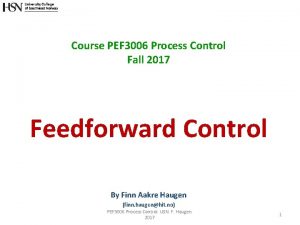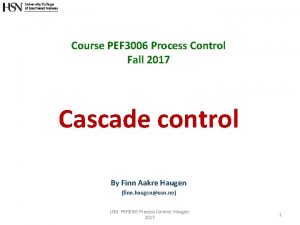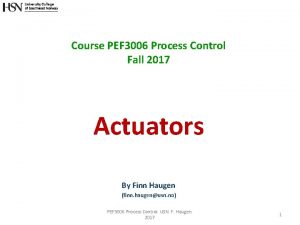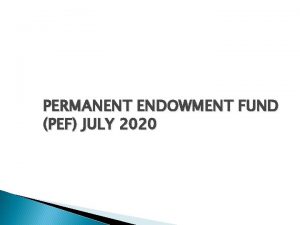Course PEF 3006 Process Control Fall 2018 Tuning


















- Slides: 18

Course PEF 3006 Process Control Fall 2018 Tuning of PID controllers By Finn Aakre Haugen (finn. haugen@usn. no) PEF 3006 Process Control. USN. F. Haugen. 2018 1

2 Ziegler-Nichols' closed loop method PEF 3006 Process Control. USN. F. Haugen. 2018 2

Aim of tuning: As fast control as possible, but with acceptable stability, i. e. ¼ decay ratio 3 Disturbance step: Response in controlled process output: A 2/A 1 = 1/4 PEF 3006 Process Control. USN. F. Haugen. 2018 3

4 Experimental setup in Ziegler-Nichols’ method: The PID controller is turned into a P controller during the tuning Oscillations with P controller with critical controller gain, Kpu PEF 3006 Process Control. USN. F. Haugen. 2018 4

Tuning procedure of Ziegler-Nichols’ method: 5 1. With controller in manual mode: Bring the process to the specified operating point by manually adjusting the control variable until the process variable is approx. equal to setpoint. 2. Turn PID controller into P controller with gain Kp = 0. (Ti = very large. Td = 0. ) 3. Set the controller to automatic mode. 4. Increase gain Kp (you may start with Kp = 1) until there are steady oscillations in the loop due to a small setpoint step. This controller gain value is the ultimate gain, Kpu. Read off the period, Pu, of the oscillations. 5. Calculate controller parameters from the Z-N formulas: Recommends "Relaxed ZN PItuning" (cf. article by FH og B. Lie in Modeling, Identification and Control): Kp = 0, 32*Kpu og Ti = Pu. PEF 3006 Process Control. USN. F. Haugen. 2018 5

6 Let’s try Z-N tuning of a PI controller on this simulator: Temperature Control of Liquid Tank PEF 3006 Process Control. USN. F. Haugen. 2018 6

7 Repeated Ziegler-Nichols method (for PI contollers) PEF 3006 Process Control. USN. F. Haugen. 2018 7

Assume that the PI settings are Kp 0 and Ti 0, and that the control system - unfortunately - has poor stability with these settings showing poorly damped oscillations with period Pu. Improved PI setting can be obtained by applying ZN tuning assuming that these oscillations are true ZN oscillations: Kp = 0. 45 Kp 0 Ti = Pu/1. 2 F. Haugen. Process Control. NMBU. 2018. 8

Repeated ZN Original ZN Ex. : PI controller in simulated biogas control system Big improvement! F. Haugen. Process Control. NMBU. 2018. 9

10 Let's try (assuming the initial PI tuning is with ZN): Temperature Control of Liquid Tank PEF 3006 Process Control. USN. F. Haugen. 2018 10

11 Auto-tuning (automatic PID tuning) PEF 3006 Process Control. USN. F. Haugen. 2018 11

Example of auto-tuner: The Relay or On/Off tuner (by Åström and Hägglund). Sustained oscillations come automatically in control loop. From the amplitude and the period of these oscillations proper PID controller parameters are calculated by an algorithm in the controller. Amplitude A Amplitude Y Period Pu PEF 3006 Process Control. USN. F. Haugen. 2018 In Ziegler-Nichols’: Use Pu and Kpu = 4*A/(pi*Y). 12

13 Example: Relay-tuning of a PI temperature controller: Temperature Control of Liquid Tank PEF 3006 Process Control. USN. F. Haugen. 2018 13

14 Skogestad's method PEF 3006 Process Control. USN. F. Haugen. 2018 14

Skogestad’s method is a model-based method, but the model parameters may stem from a simple step-response test on the process. You must specify the time-constant Tc of the closed-loop system (illustrated below with setpoint step response): tau is process time-delay PEF 3006 Process Control. USN. F. Haugen. 2018 15

Skogestad’s PI-tuning for a ”integrator with time-delay” process Find model parameters K and tau from process step response (or from a mathematical process model, if you have one): (If time-delay is disregarded) PI controller settings: Kp = 1/[Ki*(Tc + tau)] = 1/(2*Ki*tau) if Tc = tau. Ti = 2(Tc + tau) = 4*tau if Tc = tau. Skogestad uses 4 in stead of 2 in the T i formula, but you get faster disturbance compensation with 2. If you do not know how to specify Tc, Skogestad suggests Tc = tau. But if the process has negligible tau, you can not set Tc = tau. Then you must select Tc by yourself. PEF 3006 Process Control. USN. F. Haugen. 2018 16

PEF 3006 Process Control. USN. F. Haugen. 2018 17

18 Let’s try Temperature control of liquid tank PEF 3006 Process Control. USN. F. Haugen. 2018 18
 Pef nigeria
Pef nigeria Pef in asthma
Pef in asthma Pef viitearvo
Pef viitearvo Ul 1666
Ul 1666 Kei+pei=kef+pef refers to
Kei+pei=kef+pef refers to Tracheomalaci barn
Tracheomalaci barn Pef ecografia
Pef ecografia Petroleum equalization fund board members
Petroleum equalization fund board members Quality alert example
Quality alert example Jenis usaha apa
Jenis usaha apa Pef pet
Pef pet B a f c j e
B a f c j e Product inspection vs process control
Product inspection vs process control T junction brick wall
T junction brick wall Course title and course number
Course title and course number Chaine parallèle muscle
Chaine parallèle muscle Business process outsourcing training
Business process outsourcing training Windows xp tuning
Windows xp tuning Tuning bases de datos
Tuning bases de datos



